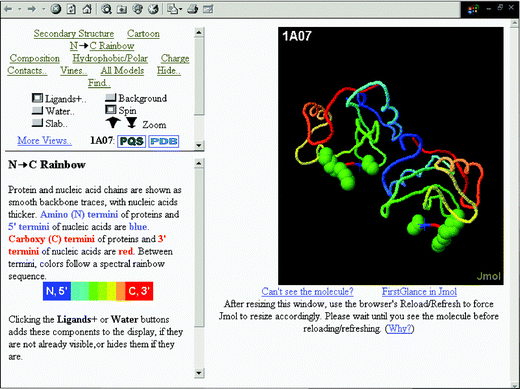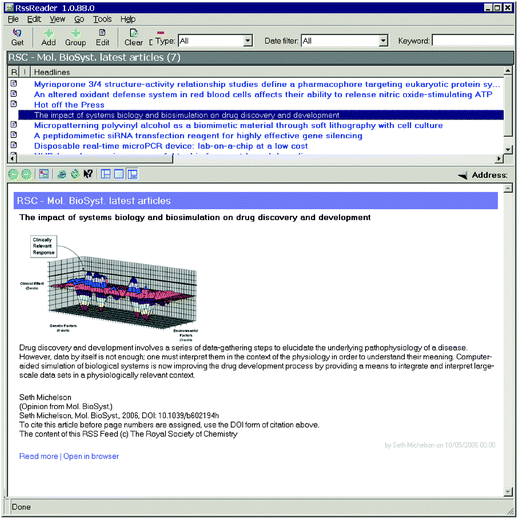Added value online features for Molecular BioSystems
Molecular BioSystems has been busy celebrating its first successful year of publication. So what does the future hold for the Journal? A recent exciting development for Molecular BioSystems is the provision of additional online features for our authors and readers.With Molecular BioSystems there are of course all the usual benefits of publishing with the RSC: fast publication times, no page charges, free colour where scientifically necessary, a professional editorial and production service, free electronic reprints, high visibility, the opportunity to have your work featured on the cover of the journal and eligibility to apply for author grants.
The RSC's Electronic Supplementary Information (ESI) also provides a free facility to enable all authors to enhance and increase the impact of their articles. ESI allows authors to exploit their data to the full with the use of full colour diagrams and even movies. Molecular BioSystems’ authors are strongly encouraged to make use of ESI to support and enhance their articles.
Molecular BioSystems now offers some additional innovative publishing features that are available through articles and their associated ESI pages (see Fig. 1). These features will add further value to the journal articles with the aim to enhance the readers' experience. Listed below are details of these exciting new electronic developments:
Database linking
All manuscripts that report novel macromolecular three-dimensional structures at the level of individual atomic positions are accompanied by the deposition of the required structural data in the appropriate database. Links to data deposited in PubChem, wwwPDB, Swissprot and GenBank can be included in any article published in Molecular BioSystems. | ||
| Fig. 1 ESI page from a Molecular BioSystems' article containing links to the PDB file viewer FirstGlance, ChemDraw files, Graphical Contents entry and significant figures. | ||
ChemDraw and ISISDraw figures
Important and significant structures are freely available to all readers as part of the RSC's established ESI service (see links in Fig. 1). Links to ChemDraw and ISISDraw files, which can be downloaded, can now be provided from the Molecular BioSystems’ published article.Crystallographic data
Supplementary crystallographic data is deposited with the Cambridge Crystallographic Data Centre (CCDC) as part of the assessment process. The data can then be accessed via the ESI page once the article is published.Graphical abstracts
As for all RSC journals, Graphical Abstracts are provided for both Advance Articles and full Table of Contents—providing readers with easy-to-browse, visual summaries of the content of Molecular BioSystems' articles.3D visualisation for complex molecules
Molecular BioSystems now provides a new service that enables the 3D visualisation of complex molecules. This is made possible by using the PDB identification code to generate an image using FirstGlance in Jmol (http://firstglance.jmol.org) (Fig. 2). Viewing the resulting image in the free online applet is easy. The software has a range of powerful functionalities that allow readers to manipulate molecules in a number of diverse ways. You can rotate molecules, customise the view, zoom in on specific areas of interest, change the background, hide ligands and show water molecules. In addition to this it is also possible to display colour-coded amino acid side chains and nucleotide bases, and view molecules as space-filling spheres or as the secondary helical or stranded structure. All authors need to do is provide the PDB identification code on submission of their article and we do the rest. When a paper is published online, links to the 3D images can be found on the ESI page of the online article. | ||
| Fig. 2 3D visualisation of molecules using FirstGlance in Jmol. | ||
RSS feeds
You can also sign up for RSS feeds which contain both the graphical abstract and the text from the journal's contents page, giving you access to new research, direct to your PC, as soon as it is published (Fig. 3). | ||
| Fig. 3 RSS feeds give access to new research, direct to your PC, as soon as it is published. | ||
We hope these additional online benefits will add value to the excellent scientific content published in Molecular BioSystems. We'd like to know your thoughts on these new features, so please email molbiosyst@rsc.org with your comments.
Kathryn Sear
Deputy Editor
| This journal is © The Royal Society of Chemistry 2006 |

